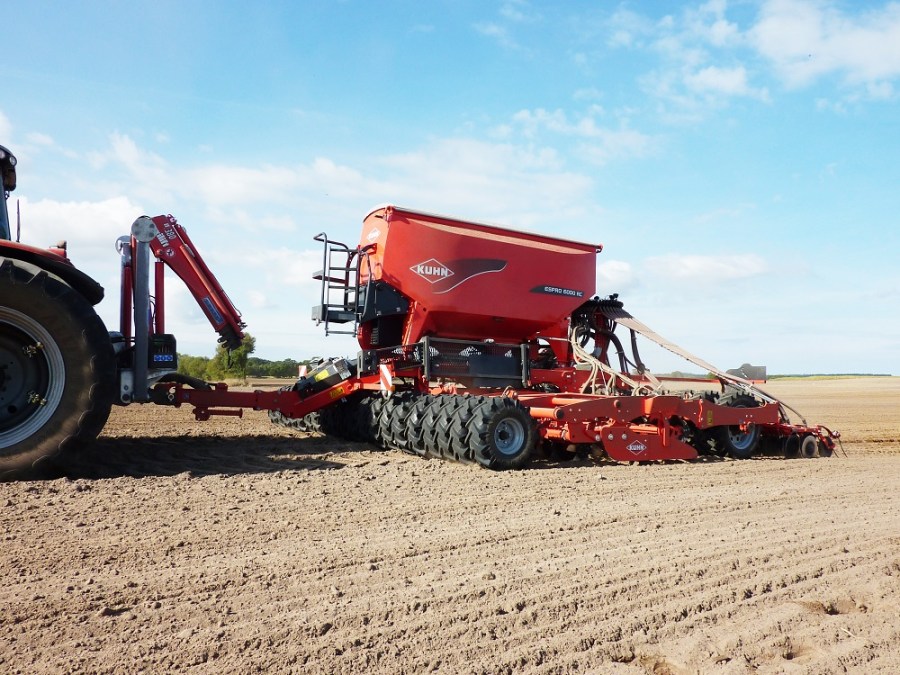Functionality and flexibility are the boasts of many drill manufacturers, and allow many jobs in one pass. CPM explores the range of multi-function drills to assess what they master.
You get exact fertiliser placement at the right time to give seed the best possible chance of a strong, even germination.
By Jane Brooks
Working on the principle there’s no magic bullet in farming and the only remedy is being flexible to suit changing conditions, where does this place the drills which place seed and fertiliser in one pass, work in stubble or after the plough? Nothing guarantees success in all situations, but these will have a good old go.
Seed and Feed
Kuhn has added a combination version to its line-up of Espro trailed min-till drills – the 6m working-width Espro 6000 RC. The new model offers one-pass seed and fertiliser placement and is designed for use after the plough as well as on stubble with crop residues to incorporate into the soil.
In common with other drills in the range, the Espro 6000 RC uses two rows of cultivating discs followed by a single row of large diameter (900mm) press wheels which are offset and fitted with specially designed deep-tread tyres to create a seedbed.
An additional row of single disc coulters behind the working discs precisely places either fertiliser or a second seed variety in front of the press wheels and equidistant from the two main rows of seed.
The Espro RC is fitted with a 5500-litre twin-compartment hopper, divided on a 60/40 (fertiliser/seed) basis. Optional front press wheels with in-cab pressure adjustment can be added to provide a level soil surface ahead of the working discs.
Will Waterer, non-inversion specialist for Kuhn UK, believes the benefits go further than just reducing the total number of passes required to seed and feed a new crop. “Combination drills such as the Espro RC use two separate metering and distribution systems for each half of the main hopper. This means you get exact fertiliser placement at the right time to give seed the best possible chance of a strong, even germination,” he points out.
“The Espro RC is capable of working in very high residue conditions and as well as accurate seed and fertiliser placement, can alternatively drill two seed varieties simultaneously. This gives users the flexibility to drill and fertilise in tandem, to drill two main crop varieties or a mixture of seed varieties with each sown to a different depth.”
Versatility delivery
The Simtech T-Sem 600AC trailed drill is available in 6 or 8m working widths, has a 4100-litre seed and fertiliser hopper and is available for seed only or seed and fertiliser. Electric metering is standard and it folds down to a transport width of 3m. Adding an optional third micro hopper also allows materials such as slug pellets to be sown at the time of drilling.
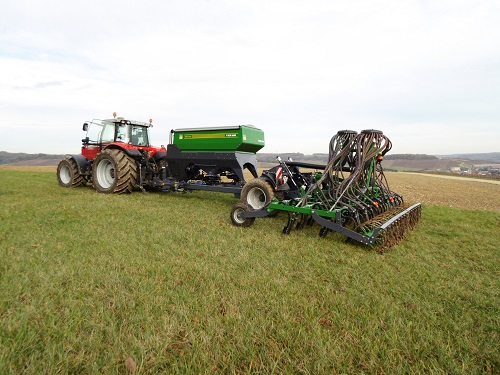
Although essentially designed as a direct drill, the T-Sem 600AC trailed drill is capable on any kind of surface.
Using the same Disc/Tine/Roller configuration as all smaller T-Sem models, the AC drill adds the ability to apply fertiliser with the seed or to carry larger loads for longer working times before refilling.
A row of straight discs opens the slot in advance of three rows of spring-tine mounted T-Sem coulters. These prepare an upside-down T-slot seedbed. Behind the tines is a springflex roller, passing between the rows and a harrow, which crumbles and levels without over-firming the slot itself.
It’s Simtech’s latest production model, says the firm’s Simon Clark, essentially designed as a direct drill. “But the nature of all our drills is that they’re very versatile and capable on any kind of surface.”
With the introduction of a grain and fertiliser version of the Express KR power harrow combi-drill, all of Horsch’s UK drills now have either a grain only or dual option. Hopper capacity of the Express KR is 2000 litres, with space for a tonne each of seed and fertiliser.
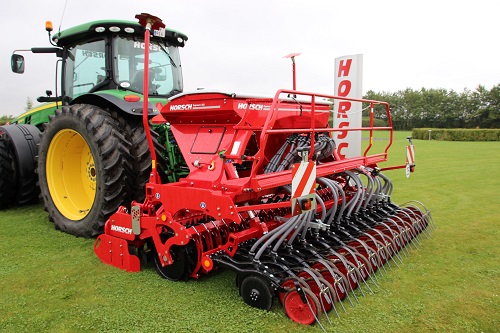
With the introduction of the grain and fertiliser version of the Express KR, all of Horsch’s UK drills now have either a grain only or dual option.
Available in 3, 3.5 and 4m widths, the drill uses Horsch TurboDisc 2 coulters. Each coulter has four rubber dampers, which transfer up to 120kg to each disc. They can be lifted out of work when just the power harrow is needed or the drill can be removed by just releasing four couplings.
Amazone’s Cayena 6001-C trailed tine seeder has a 4000-litre seed hopper, divided in two compartments in a ratio of 60:40 and equipped with two independent, fully electric metering units.
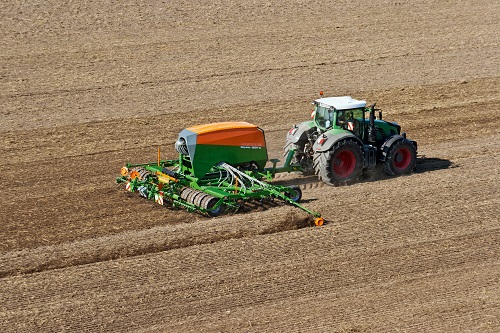
Amazone’s Cayena 6001-C trailed tine seeder has a dual compartment 4000-litre seed hopper equipped with two independent, fully electric metering units.
Both compartments take seed or fertiliser, which are placed together in the seed furrow via the same conveying system. The sealed, pressurised tank system of the Cayena-C, ensures correct application of the seed-fertiliser combination.
The drill comes with three rows of coulters in a working width of 6m, has variable seed rate capability and optional section control. It’s designed for high-speed sowing on hard, dry and stony soils with or without prior soil tillage.
Its narrow TineTec coulters are ideal for low disturbance drilling, meaning less potential weed germination between rows and their thin profile also reduces drag, so a tractor of just 140-150hp can lug it along, says Amazone. The three-row coulter stagger provides row spacing of 16.6cm.
The drill is certified as UT 2.0 according to the AEF conformity test system. This means the full functionality of the drill can be achieved with any terminal on the market, which is also certified to UT 2.0 or above.
Control is via an ISOBUS-compatible Section Control licence from another ISOBUS terminal or with one of Amazone’s Amatron 3, CCI 100 and Amapad terminals. All Amazone ISOBUS machines support the AEF functionality AUX-N, meaning for example, a function can be individually assigned to any key on an existing AUX-N compatible multi-function joystick for more comfortable control.
“Using the Cayena for both seed and fertiliser tends to be based on the availability of phosphate to the emerging crop,” notes Simon Brown of Amazone. “Although soil indices may be high, P is extremely immobile and direct contact of the plant root with phosphate ions can improve early development. This gives the crop a stronger root structure and allows the plant to feed itself better and draw in groundwater throughout the growing season. Hopefully this’ll lead to higher yields and greater grain fill.”
For most growers, TSP (triple super phosphate) will be the chosen fertiliser for autumn cereals, but with autumn oilseed rape, adding N in the form of DAP (diammonium phosphate), or maybe ASS (ammonium sulphate saltpetre), means nitrogen removal caused by the breakdown of the straw in the seedbed is countered by the provision of N in the direct seed area, he explains.
“The banding effect of fertiliser in the coulter means higher application rates can be used without exceeding maximum N input in the autumn. Around 40% of our trailed drills now sell as C versions. The second tank can also be used for sowing two varieties of seed.”
Updates and accessories
Sulky has updated its XEOS TF front hopper frame allowing increased capacity and better stability regardless of the drilling toolbar used.
The maximum front ballast load is 1500kg without counting the load in the hopper, which can be more than 900kg. Hopper capacities of 1000, 1500 and 1800 litres are available and can be combined with a variety of drilling toolbars, offering widths of between 3m and 6m.
This year, Alpego introduced the ASMax 2300-litre twin hopper made of Inox stainless steel, suitable for the following uses: fertiliser and seed from 3m to 4m rigid, fertiliser and seed from 4m to 6m folding, seed only for 7m and 8m configurations. Its movable bulkhead allows two different seed/fertiliser configurations (50:50 or 33:67) or completely removed for seed only applications.
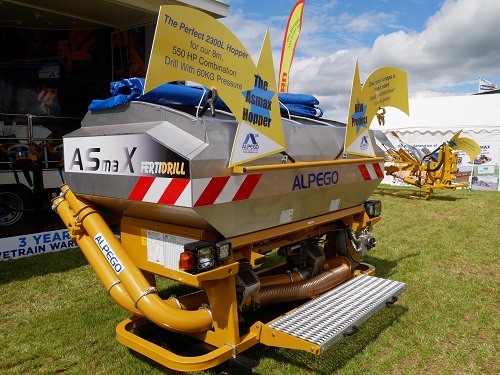
Alpego’s ASMax 2300-litre twin hopper has a movable bulkhead that allows two different configurations or completely removes for seed only applications.
Metering units are made from non-corrosive stainless steel, brass and plastic nylon, ensuring any parts of the machine which come into contact with seed or fertiliser are protected. When using a grain and fertiliser application, the coulter shoe is made from stainless steel.
The drill has “Turbo Rotal” – an innovative spinning impellor system located in the centre of the distribution head ensuring even distribution of seed through the outlets when working on hills.
It’s equipped with a folding front loading platform, 2nd category front three-point hitch, headlights, working LED lights and reflectors, together with a 600kg ballast holder.
The distribution system allows the delivery of high quantities of product both in terms of working width and speed. Featuring a complete ISOBUS system, it can be managed directly from the tractor screen or from an ISOBUS screen, which can be supplied separately.
“The use of grain and fertiliser in a one-pass system is a traditional sight in Scotland, but the trend’s working its way further south,” says Alpego’s Warren Rivers-Scott, “With blackgrass an ever-increasing problem, farmers are using a plethora of tools, such as rotations, chemistry and cultivations, to try to combat this robust weed.
“One key aspect that circumnavigates these practices is timeliness of the drilling program. To allow chemicals to work on germinating blackgrass, the drilling window moves backwards into the wetter part of the year. Sometimes our changing weather patterns force farmers to drill in the spring, so fertiliser placement helps give early seed germination a head start.”
Väderstad’s ‘SeedEye’ automatic calibration system allows farmers to set the number of seeds per m² without the need for calibration tests. The company says counting seeds is more exact than calculating quantity based on seed weight.
Units each consisting of six infrared optical sensors are placed in the seed tubes. Individual seeds block the light rays for a moment, which is recorded by an optical transistor.
The total number of ‘breaks’ is processed, resulting in a seed volume measurement, which Väderstad says is 99% accurate in OSR and 98-99% in cereal seeds at a rate of 250 seeds per sec.
The seed volume per m² is set by iPad through Väderstad’s in-cab E-Control system. The drill’s radar measures forward speed, and works with the E-Control to continuously calculate the seed volume, adjusting the seed feed as necessary to match the programmed seed rate. SeedEye also detects seed hose blockages, setting off an in-cab alarm.
Seeding rate changes are via iPad and happen instantaneously regardless of the tractor’s forward speed. The system also adjusts for dust or residue build-up on the sensors.
The system’s currently an option for Väderstad Rapid A 400-800S and Rapid A 600-800C drill units.
Electric checks save downtime in the field
Getting the best out of a drill means setting it up correctly and time spent familiarising yourself with controls, checking wiring and sensors, can save downtime in the field when a problem arises, reckons Laurence Hoggins, technical manager at Ellis Machinery of Gaydon in Warwicks.
“Reading the manuals and instructions gives you chapter and verse on how to set up and calibrate the machine and a brief overview of pre-work checks. They also describe how to remedy various problems so are worth checking before consulting a technician,” he notes.
“Ensure the control box or drill sensors are receiving 12 Volts – Väderstad Control Stations and Ag-tron boxes are susceptible to low voltage. My advice is that it’s sometimes best to wire straight off the tractor battery. Also Stocks and KRM air-seeders need a good amp supply to get the fans going so they should be wired off direct.”
He advises checking polarity from the power source. “The three-pin plug’s a common area where positive and negative can get swapped. If it’s done on a Väderstad Control Station it can cause damage.”
Further advice is to check fuses if the controls won’t power up. Older Väderstad black control boxes and newer Control Stations have a re-set fuse, which easily trips out, he notes.
A common problem is the wrong settings on a control box. “Check the control box for simple things: is the sensor turned off? Is it recognising the right drill model and size? Is the tramlining on asymmetrical and not symmetrical – this will make tramlines work differently.”
Inspect plugs and sockets regularly for damage, loose wires and bent pins, he continues. “Run your fingers down the pins, as they may seem OK, but push in when the connection’s made. Three-pin plug spade-connections commonly come off if they’re not soldered on.
“Badly corroded plugs and sockets can lose connection. Look for rodent damage, cuts, squashed or badly bent cables. Occasionally wires loosen in connection boxes, causing shorts.”
He also points out some drill controls have a delay on the bout sensors, which can stop the bout moving on if switched on too quickly, especially toggle switches. “Hydraulics can create problems. Change over valves can seize or wear affecting bout marker operation. Worn male ends or air in the hydraulic system can also cause malfunction.
“Another hotspot is sensors – check for damage, although some control boxes have a self-checking mode. Many sensors have an LED on the end which is either on all the time or when activated. A lot of hopper sensors work by moisture, so use your hand to activate them.”
Some drills use electronic solenoids to stop and start mechanisms, points out Laurence Hoggins. “These can seize and need freeing up with some WD40. This also applies to Accord-type tramlining mag-valves. If you unscrew the little side plate you can get them going in there.”
Finally he suggests ensuring the magnet or metal stub the sensor registers isn’t missing or too far away. “This is common on Accord fan sensors as the metal spike can loosen and slide down the shaft away from the sensor. Some sensors need to be within 2mm of the stub.”

